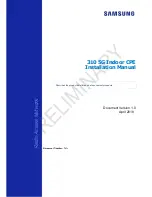
ODIN-W2 series - System integration manual
UBX-14040040 - R20
Design-in
Page 28 of 43
C1-Public
During high ambient temperature, it is critical to dissipate the generated heat efficiently to keep the
die temperature low.
3.8.1
Thermal protection
The ODIN-W2 module has built in thermal protection if the die temperature reaches too high levels.
The following two preventive steps are implemented in the ODIN-W2 series module to control heating:
•
Disable/Enable MIMO: When the die temperature exceeds high threshold, +103 °C device will
switch to SISO rates only (as MIMO PA heating is the main contributor for heating).
•
Halt TX: Suspend traffic to allow device cooling when maximum allowable die temperature of +120
°C is reached.
When the die temperature returns below the low threshold limit of +80 °C, the device will automatically
Enable MIMO and TX transmission.
3.8.2
Heat dissipation
It is critical to design the host board in such a way that generated heat from the ODIN-W2 series
module will be dissipated efficiently. Use the different approaches as mentioned below to achieve this:
•
Connect each ground pin on the ODIN-W2 series module with a solid ground layer on the
application board on both the top layer and with multiple vias to other GND planes on lower layers.
•
Provide a ground plane as wide as possible on the application board.
•
Optimize the thermal design of any high power component included in the application, such as
linear regulators and amplifiers to minimize the temperature distribution in the application device.
•
Select the material, thickness and surface of the mechanical enclosure of the end product in such
a way that it provides good thermal dissipation.
•
Force ventilation air-flow within the mechanical enclosure.
•
Provide a heat sink component attached to the application board, on the opposite side of the
ODIN-W2 module, as a large part of the heat is transported through the GND pads and dissipated
over the backside of the application device.
3.9
ESD guidelines
The ODIN-W2 series module contains no ESD protection on any signals. Required ESD protection
must be implemented by the interface board.
3.10
Schematic for ODIN-W2
Figure 10 is an example of an ODIN-W2 connected to a 3.3V application:
•
A 3.3 V/1.8 level converter (Texas Instrument
) is between the 3.3 V application
processor and the 1.8 V ODIN-W2 UART Interface. The level converter is an 8-bit bidirectional
voltage-level translator for Open-Drain and Push-Pull Application. Maximum speed for Push-Pull
is 60 Mbps. If fewer signals are used (for example, only TxD/RxD and RTS/CTS)
could be a good choice (2x2 bits). The level converter is supplied with 1.8 V from the ODIN-W2
V_INT output supply pin.
•
The external LPO clock is at 1.8 V level. In the example below, a 3.3V LPO is available in the
application and shared with the ODIN-W2 through the 3.3/1.8V level converter.
•
An RGB LED is controlled by the LED signals through the open drain “glue” logic 74LVC3G07. The
logic gates are supplied with 1.8 V from the ODIN-W2 V_INT output supply pin.
•
Push buttons are connected to the SWITCH_0, SWITCH_1 and RESET_N signals. If the button
pins have to be externally accessible on the application device, an ESD protection device should be
provided close to accessible point. The SWITCH_1 button is connected through series resistors to
prevent a short circuit when the multiplexed (GREEN/SWITCH_1) signal is high.
















































